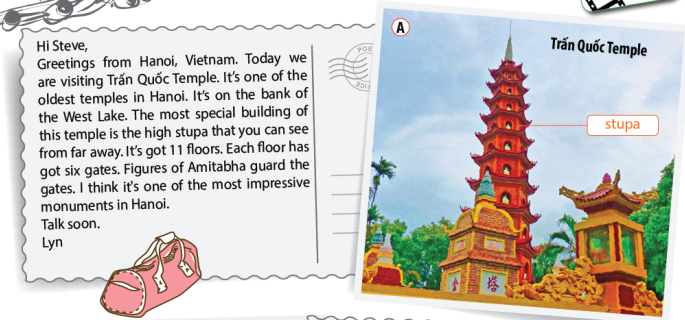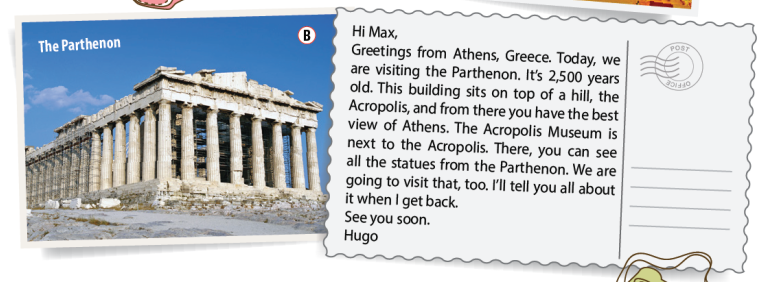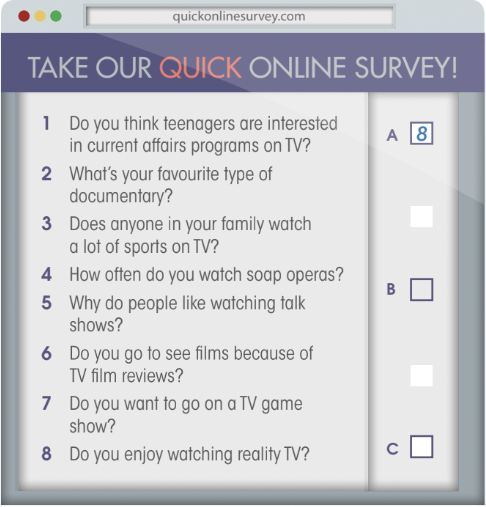2. Reading the postcards again. Which monument, A or B …
(Đọc lại bưu thiếp. Đâu là di tích, A hoặc B …)
1. has a lot of floors? ロ
2. has a museum nearby? ロ
3. is on the bank of a lake? ロ
4. gives you a great view of the city? ロ
|
1. A |
2. B |
3. A |
4. B |
1. A.
has a lot of floors (có nhiều tầng).
Thông tin: “It’s got 11 floors.” (Nó có 11 tầng.)
2. B
has a museum nearby (ở gần một bảo tàng.)
Thông tin: “The Acropolis Museum is next to the Acropolis.”
(Bảo tàng Acropolis nằm cạnh Acropolis.)
3. A
is on the bank of a lake.
Thông tin: “It’s on the bank of the West Lake.”
(Nó nằm trên bờ hồ Tây.)
4. B
gives you a great view of the city.
Thông tin: “This building sits on top of a hill, the Acropolis, and from there you have the best view of Athens.”
(Tòa nhà này nằm trên đỉnh đồi, Acropolis, và đứng từ đáy bạn có được tầm nhìn ra Athens đẹp nhất.)

Các bài tập cùng chuyên đề
2. Read and listen to the text and check your answers to exercise 1.
(Đọc và nghe văn bản và kiểm tra câu trả lời của bạn cho bài tập 1.)
Thanks giving Day
Americans celebrate the Thanksgiving holiday on the fourth Thursday of November. Families meet for a special meal including turkey, corn, potatoes and pumpkin pie – a popular dessert. Then families do activities together or watch TV.
The Thanksgiving festival celebrates the first harvest of the Pilgrims – a group of religious settlers. In September 1620, they left England for America on a ship – the Mayflower. That winter, when they arrived, they were very cold and didn't have enough food. So half of them died. A Native American leader, Squanto, visited the settlers. His people showed the settlers how to grow corn and vegetables and how to hunt animals for food.
In autumn 1621, after a good harvest, the Pilgrims held a big celebration to thank God. They invited the Native Americans. For three days, they ate together. Also, they played games, sang songs and danced. It was the start of a long tradition.
3. Read the text again and answer the questions.
(Đọc lại văn bản và trả lời các câu hỏi.)
1. What do people eat on Thanksgiving Day?
2. Where did the Pilgrims arrive in 1620?
3. Why did many settlers die in the first winter?
4. How did they learn to grow food?
5. Who went to the first Thanksgiving meal?
1. Look at the pictures. What do these gestures mean to you? What do you think the blog post is about? Listen and read to find out.
(Hãy nhìn vào bức tranh. Những cử chỉ, dáng điệu này có ý nghĩa gì đối với bạn? Bạn nghĩ nội dung bài đăng trên blog là về gì? Lắng nghe và đọc để tìm ra.)

2. Read the blog again. Decide if the statements are R(right), W(wrong) or DS (doesn’t say).
(Đọc bài blog một lần nữa. Đưa ra quyết định về các câu nói rằng đúng, sai hay không có nói đến.)
| 1. Antonio is in Madrid right now. | |
| 2. In Spain, people only hug their family and close friend. | |
| 3. Mia goes on holiday to Thailand every year. | |
| 4. The thumps up means “zero” in Thailand. | |
| 5.In Bulgaria, nodding your head means “yes”. |
2. Read again and match the headings to the paragraphs. Look for keywords to help you do the task.
(Đọc lại một lần nữa và nối những tiêu đề với đoạn văn. Tìm những từ khóa giúp bạn làm nhiệm vụ.)

3. What is the author’s purpose: to answer? To persuade? to inform? Is the information in the text useful to you? Why?
(Mục đích của tác giả là gì : để trả lời ? để thuyết phục ? để cung cấp thông tin ? thông tin trong bài hữu ích cho bạn không ? Vì sao?)
Listening and Reading (Phần nghe và phần đọc)
1. Look at the monuments in the pictures. Where is each? Listen and read to find out.
(Nhìn vào các di tích trong ảnh. Mỗi di tích đấy ở đâu? Nghe và đọc để tìm hiểu.)


Hi Steve,
Greetings from Hanoi, Vietnam. Today we are visiting Trấn Quốc Temple. It’s one of the oldest temples in Hanoi. It’s on the bank of the West Lake. The most special building of this temple is the high stupa that you can see from far away. It’s got 11 floors. Each floor has got six gates. Figures of Amitabha guard the gates. I think it’s one of the most impressive monuments in Hanoi.
Talk soon.
Lyn
Hi Max,
Greetings from Athens, Greece. Today, we are visiting the Parthenon. It’s 2, 500 years old. This building sits on top of a hill, the Acropolis, and from there you have the best view of Athens. The Acropolis Museum is next to the Acropolis. There, you can see all the statues from the Parthenon. We are going to visit that, too. I’ll tell you all about it when I get back.
See you soon.
Hugo.
Your turn (Lượt của bạn)
6. Brainstorming: Read the task in Exercise 1. Use ideas from Exercise 5 to make notes under the headings gesture, what it means in my country and what it means in another country.
(Tư duy: Đọc nhiệm vụ trong Bài tập 1. Sử dụng các ý từ Bài tập 5 để ghi chú lại dưới đề mục cử chỉ, ý nghĩa của nó ở đất nước tôi và nó có nghĩa gì ở nước khác.)
1. Read Rose’s blog. How are Rose and her sister, Violet different?
(Đọc nhật kí trực tuyến của Rose. Rose và em gái của cô ấy là Violet khác nhau như thế nào?)
Rose studies art, but Violet studies music.
(Rose học vẽ nhưng Violet học âm nhạc.)
MY SISTER & ME
We look the same, but we don’t like the same things.
Violet studies classical music, but I study art. She reads novels and poems, but I don’t read much. She often watches TV, but I don’t - it doesn’t interest me.
Violet writes poems. I write texts on my phone. I paint pictures. Violet tries to paint, but she never finishes her paintings.
She doesn’t understand art! I love hip-hop.
She says that hip-hop annoys her.
2. Read the first paragraph of the text. What do you think these phrases mean?
(Đọc đoạn đầu của văn bản. Bạn nghĩ những câu sau nghĩa là gì?)
a. a couch potato
b. to have square eyes
3. Read the rest of the test. Match headings a-e with paragraphs 1-4. There is one extra heading.
(Đọc phần còn lại của bài kiểm tra. Ghép các tiêu đề a-e với các đoạn văn 1-4. Có một tiêu đề bổ sung.)
a. a global change
b. Surprising statistics
c. TV is cool again
d. Two much busy?
e. A new activity?
Where are all the couch potatoes?
|
1 |
Parents and teachers always say that teenagers are “couch potatoes” and spend all their time in front of stupid TV programmes. But is it true that young people have “square eyes”? Do they really watch a lot of TV?
(Cha mẹ và giáo viên luôn luôn nói rằng thanh thiếu niên là “những củ khoai tây ngồi trên ghế sô pha” và dành toàn bộ thời gian của họ trước các chương trình truyền hình ngu ngốc. Nhưng có thật là giới trẻ hiện nay có “những đôi mắt vuông”? Có thật sự là họ xem tivi rất nhiều không?)
|
2 |
The results of a recent survey show that young people don’t watch as much TV as adults. For example, middle-aged adults watch about five hours a day. But young people only watch about two and a half hours a day. And a typical pensioner watches about six hours a day!
(Theo kết quả của một cuộc khảo sát gần đây cho thấy rằng những người trẻ tuổi không xem tivi nhiều như người lớn. Ví dụ, những người ở độ tuổi trung niên xem khoảng năm giờ một ngày. Nhưng người trẻ chỉ xem khoảng hai tiếng rưỡi một ngày. Và một người hưu trí điển hình xem khoảng sáu giờ một ngày!)
|
3 |
Studies in many countries such as the USA and Australia suggest the same results: kids today spend less time in front of their TV sets than young people in the 1980s.
(Các nghiên cứu ở nhiều quốc gia như Hoa Kỳ và Úc cho kết quả tương tự: trẻ em ngày nay dành ít thời gian trước màn hình tivi hơn những người trẻ trong những năm 1980.)
|
4 |
Teenagers today don’t often sit with their families on the living-room couch. The couch potato is alive and well - he’s just back in his bedroom surfing the Internet.
(Thanh thiếu niên ngày nay không thường xuyên ngồi cùng gia đình trên ghế dài trong phòng khách. Những củ khoai tây ngồi trên ghế sô pha vẫn còn sống khỏe - anh ấy vừa trở về phòng ngủ lướt mạng.)
4. Find the following words in the reading text. What do they mean?
(Tìm các từ sau trong bài đọc. Chúng có ý nghĩa gì?)
|
Vocabulary |
|
adults kids middle-aged (people) pensioners teenagers |
5. Read the text again. Mark the sentences ✔️(right), ❌(wrong) or ❓(doesn’t say).
(Đọc lại đoạn văn. Đánh dấu các câu ✔️(đúng), ❌(sai) or ❓(không đề cập).)
1. Parents and teachers agree that teenagers watch too much TV.
2. Middle-aged people spend more time watching TV than teenagers.
3. Pensioners watch six hours of TV a week.
4. Teenagers don’t watch TV because they prefer to be outside in the fresh air.
5. Teenagers in Britain usually have a TV in their bedrooms.
1. Look at the cinema programme and say what types of film are on. Which ones would you like to see?
(Nhìn vào phần chương trình chiếu phim và nói những loại phim đang chiếu. Bạn thích xem phim nào?)
I think “The Jungle Book” is an interesting fantasy film. I’d like to see it.
(Tôi nghĩ “Cậu bé rừng xanh” là một bộ phim huyền ảo thú vị. Tôi muốn xem bộ phim đó.)
Nam: So, what’s on?
Mai: The Jungle Book. It starts in ten minutes.
Nam: No way! I want to see ZooWorld.
Mai: I don’t like it. It’s boring.
Nam: Oh, come on, please.
Mai: Oh, OK.
…
Nam: Can I have two tickets for ZooWorld, please?
Tú: Sure, which screening?
Nam: The 6.30.
Tú: I’m sorry, it’s sold out … Oh, no, hold on!
There are two seats.
Nam: Great!
Tú: But they’re in the front row.
Mai: Nam, I don’t want to sit in the front row!
Nam: OK … I’d like two for The Jungle Book at 6.15, please.
Tú: Row seven. Is that OK?
Nam: Yes, thanks. How much are they?
Tú: That’s 140,000 VND, please.
Mai: Here you are.
Tú: Thank you. Enjoy the film!
Nam: Yeah, right.
(Nam: Nào, phim gì đang chiếu vậy?
Mai: Cậu bé rừng xanh. Phim sẽ chiếu trong 10 phút nữa.
Nam: Thật á! Tôi muốn xem Thế giới động vật.
Mai: Tôi không thích phim đó. Xem chán lắm.
Nam: Ồ, thôi nào, xin đấy.
Mai: Ồ, OK.
…
Nam: Tôi có thể mua 2 vé phim Thế giới động vật, được không nhỉ?
Tú: Được thôi, suất chiếu nào vậy?
Nam: Suất chiếu 6.30 nhé.
Tú: Tiếc quá, hết vé rồi … Ôi không, từ từ đã! Vẫn còn 2 ghế trống.
Nam: Tuyệt vời!
Tú: Nhưng mà nó ở ghế đầu.
Mai: Nam, tôi không muốn ngồi hàng ghế đầu đâu!
Nam: OK … Tôi muốn mua 2 vé cho phim Cậu bé rừng xanh vào lúc 6h15, cảm ơn.
Tú: Hàng 7. Được không bạn?
Nam: Được chứ, cảm ơn bạn. Của mình hết bao nhiêu tiền vậy?
Tú: Tổng 140.000 ạ.
Mai: Mình gửi tiền nhé.
Tú: Cảm ơn bạn. Chúc bạn xem phim vui vẻ!
Nam: Tuyệt vời.)
|
No way! (Không thể nào) Come on, please! (Thôi nào) Hold on! (Từ từ) |
2. Listen and answer the questions.
(Nghe và trả lời các câu hỏi.)
1. Which film do Nam and Mai go to see?
(Nam và Mai định đi xem phim gì?)
2. What time does it start?
(Mấy giờ phim bắt đầu?)
3. How much is one ticket?
(Giá tiền của một vé xem phim là bao nhiêu?)
1. Have you got a personal webpage?
(Bạn có trang web cá nhân không?)
Nguyễn Vũ Nam
Nam Định, Việt Nam
Alternative / lofi music(nhạc rock luân chuyển / nhạc lofi)
ABOUT ME
|
1 |
My name is Nam and I’m thirteen. I’m Vietnamese. I live with my parents and my sister, Lan, in Nam Định, Việt Nam. I’m in Grade 7 at Hoa Hồng Secondary School. My favourite subjects are music, art and English. (Tôi tên là Nam và tôi 13 tuổi. Tôi là người Việt Nam. Tôi sống với bố mẹ và em gái, Lan, ở Nam Định, Việt Nam. Tôi học lớp 7 tại Trường Trung học cơ sở Hoa Hồng. Môn học yêu thích của tôi là âm nhạc, vẽ và Tiếng Anh.) |
|
2 |
I like books and movies, but my big passion is music. My favourite band is Arcade Fire - they’re from Canada and they’re awesome. In my free time, I sing and play the guitar. (Tôi thích sách và phim ảnh, nhưng niềm đam mê lớn nhất của tôi là âm nhạc. Ban nhạc yêu thích của tôi là Arcade Fire - họ đến từ Canada và họ thật tuyệt vời. Vào thời gian rảnh, tôi hát và chơi đàn ghi ta.) |
|
3 |
I make music on my laptop every day and I sometimes write songs. Click on the media player to listen to them and tell me what you think! (Tôi làm nhạc bằng máy tính cá nhân mỗi ngày và thi thoảng tôi viết nhạc. Ấn vào trình phát nhạc đa phương tiện để nghe chúng và nói cho tôi nghe cảm nghĩ của bạn nhé!) |
2. Read Nam’s webpage. Which of the following sentences are true? Write T.
(Đọc trang web cá nhân của Nam. Câu nào sau đây là đúng? Viết T.)
1. There is a photo of Nam on the webpage.
2. You can listen to some of Nam’s songs.
3. You can look at Nam’s photo gallery.
4. There is some personal information about Nam.
5. You can see some of Nam’s friends on his page.
3. In pairs, read Nam’s introduction. Tick (✔️) the things he writes about.
(Làm việc theo cặp, đọc phần giới thiệu của Nam. Đánh dấu (✔️) vào những điều mà cậu ấy viết.)
|
GEOGRAPHY (Địa lý) |
Đà Lạt |
Ðà Lạt
Đà Lạt is a capital city of Lâm Đồng province in the central highlands of Viet Nam. This city is on the LangBiang plateau. It has the average height of 1,500m above the sea level. It has both low lands and mountainous areas. There are a lot of high mountains surrounding Đà Lạt, so the climate in Da Lat is mild and temperate all year round. The average temperature in Đà Lạt is below 20°C. It is interesting to find four different types of weather in one day in Đà Lạt. It is wet and humid in the morning, hot at noon, cool in the afternoon, and cold at night. With beautiful nature, Da Lat is a popular tourist destination in Viet Nam. It is famous for lakes, hills, forests and waterfalls and a wide variety of flowers, vegetables, fruits and plants. Bà Lạt Flower Festival takes place every two years. This is a great, regular event in Đà Lạt and it attracts tourists from all over the country as well as foreign tourists.
Tạm dịch:
Đà Lạt là một thành phố thủ phủ của tỉnh Lâm Đồng thuộc vùng cao nguyên miền Trung Việt Nam. Thành phố này nằm trên cao nguyên LangBiang. Nó có độ cao trung bình 1.500m so với mực nước biển. Nó có cả vùng đất thấp và vùng núi. Xung quanh Đà Lạt có rất nhiều núi cao nên khí hậu Đà Lạt quanh năm ôn hòa. Nhiệt độ trung bình ở Đà Lạt dưới 20 ° C. Thật thú vị khi tìm thấy bốn kiểu thời tiết khác nhau trong một ngày ở Đà Lạt. Trời ẩm vào buổi sáng, nóng vào buổi trưa, mát vào buổi chiều và lạnh vào ban đêm. Với thiên nhiên tươi đẹp, Đà Lạt là một địa điểm du lịch nổi tiếng ở Việt Nam. Nó nổi tiếng với hồ, đồi, rừng và thác nước với nhiều loại hoa, rau, trái cây và thực vật phong phú. Festival Hoa Đà Lạt diễn ra hai năm một lần. Đây là một sự kiện lớn, thường xuyên ở Đà Lạt và thu hút đông đảo du khách cả nước cũng như du khách nước ngoài.
1. Work in pairs. Match the words with the photos.
(Làm việc theo cặp. Ghép các từ với các bức ảnh tương ứng.)
1. forest 2. lake 3. waterfall 4. Hill
(rừng) (hồ) (thác) (đồi)

2. Work in pairs. Do you know the names of the places in the photos?
(Làm việc theo cặp. Bạn có biết tên của những địa điểm trong ảnh không?)
3. Read the text and answer the questions.
(Đọc đoạn văn và trả lời các câu hỏi.)
1. Where is Đà Lat?
(Đà Lạt ở đâu?)
2. What is the average height of this city?
(Độ cao trung bình của thành phố này là bao nhiêu?)
3. Why does Đà Lat have a mild and temperate climate?
(Tại sao Đà Lạt có khí hậu ôn hòa, ôn hòa?)
4. What types of weather can you find in a day in Đà Lat?
(Bạn có thể tìm thấy những kiểu thời tiết nào trong một ngày ở Đà Lạt?)
5. What is Đà Lat famous for?
(Đà Lạt có gì nổi tiếng?)
6. How often does Đà Lat Flower Festival take place?
(Festival Hoa Đà Lạt thường diễn ra như thế nào?)
1. Read the text. Match paragraphs 1-3 with headings a-d. There is one extra heading.
(Đọc văn bản. Nối các đoạn từ 1-3 với các tiêu đề a-d. Có 1 tiêu đề phụ.)
a. The right time for you
(Thời điểm thích hợp cho bạn.)
b. A new way to watch TV
(Cách mới để coi tivi.)
c. Marathon TV
d. With others or alone?
(Với người khác hay một mình?)
2. Read the text again. Mark the sentences √ (right), x (wrong) or ? (doesn’t say).
(Đọc lại đoạn văn. Viết thành câu √ (đúng), x (sai) hoặc ? (không nói).)
1. The writer’s family does a lot of things together. x
(Gia đình tác giả làm rất nhiều việc cùng nhau.)
2. They usually have the same opinions.
3. The writer prefers programs without breaks.
4. The writer’s brother likes films more than docmentaries.
3. Complete the sentences with the correct words from the text.
(Hoàn thành những câu với từ đúng trong bản văn.)
live online channel advertisements
1. I want to watch the new documentary tonight. Which channel is it on?
(Tôi muốn xem phim tài liệu mới vào tối này. Kênh nào chiếu nó vậy?)
2. I often watch TV ___.
3. When I watch a film and the ___ come on, I go out and make a cup of tea or something!
4. My mum and dad never record programs. They always watch ___ TV.
3. Read the survey. Then listen and match speakers A-C with the questions 1-8. There are five extra questions.
(Đọc khảo sát. Sau đó, nghe và ghép các diễn giả A-C với các câu hỏi 1-8. Có 5 câu hỏi phụ.)

1. Read the infomation about Mai and look at the photos on her webpage. Then read her personal introduction and complete the information.
(Đọc thông tin về Mai và nhìn vào ảnh của cô ấy trên trang web. Sau đó đọc giới thiệu thông tin cá nhân cô ấy và hoàn thảnh thông tin.)
2. Decide if the sentences give us personal information (P), information about hobbies / interests (H) or information about routines (R).
(Quyết định nếu các câu cung cấp cho chúng ta thông tin cá nhân (P), thông tin về sở thích / yêu thích (H) hoặc thông tin về thói quen sinh hoạt hàng ngày (R).
1. I have one sister and two brothers.
2. I go to school by bus every day.
3. My big passion is books.
4. My best friend is Nga.
5. I live in Quang Trung District.
Read the passage. Circle the best answer A, B, or C to each of the questions.
Last week, Mai attended a cultural exchange event for both foreign and Vietnamese students in Tao Dan Park. It was so fun and useful because she had a great opportunity to communicate with many friends from other countries. That helped Mai develop her confidence as well as improve her English. Besides, it was a good occasion for making friends and finding out about various cultures from all over the world. She got acquainted with many boys and girls from Canada, New Zealand, and the UK. Among of them, she likes two Australian twin sisters, Amelia and Amanda, most. Both are quite beautiful and friendly. After the event, surprisingly they invited Mai to their home in Melbourne. They promised to take her to see kangaroos and koalas in real life. She was very glad and accepted that invitation.






